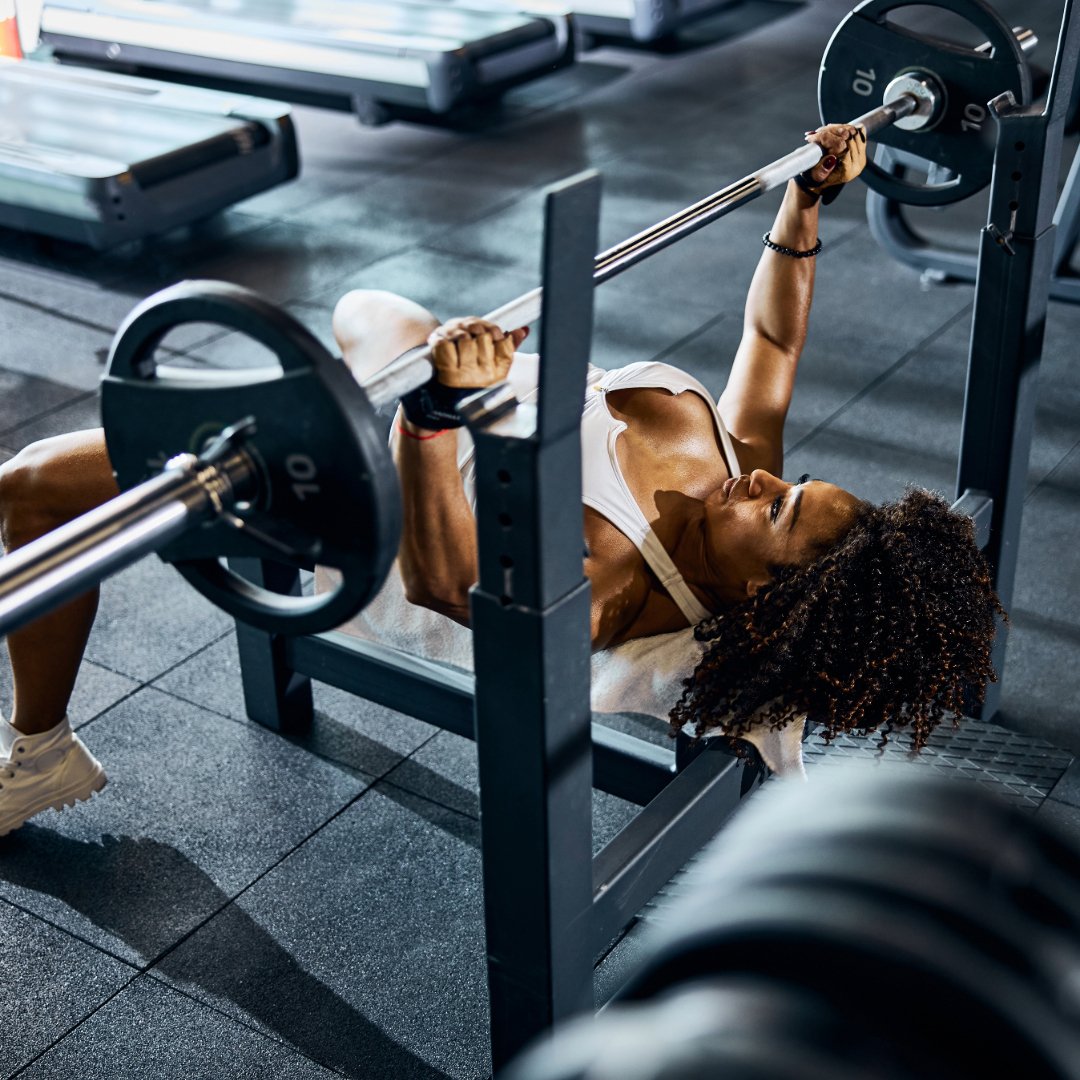
Female Powerlifters: How to Perfect Barbell Bench Press to Press More Weight
Introduction
The bench press, a cornerstone in powerlifting, is gaining momentum among women, showcasing strength beyond the barbell. This movement isn't just about pressing heavy weights; it's a narrative of empowerment, technique, and breaking through stereotypes. Our guide dives deep into mastering the bench press, from the classic barbell setup to nuanced dumbbell variations. We emphasize the importance of proper form—lowering the bar to touch your chest, pressing the weight with precision, and the critical role of the shoulder blade in safeguarding your journey.
Discover how to build muscle and strength effectively, whether on a flat, incline, or decline bench. Learn to grab the bar correctly, squeeze your shoulder blades, and engage your chest muscles and back muscles for a full upper-body workout. This article isn't just a training manual; it's a tribute to the women who've turned the bench press into a platform for empowerment, showcasing their journey from pressing the bar to pressing boundaries. Join us in celebrating strength, muscle, and the power of lifting—both weights and each other.
The Perfect Bench Press form in Powerlifting
The bench press, a cornerstone of strength training, holds a place of prominence in powerlifting, serving as a critical measure of upper body strength. This exercise, executed with a barbell, is pivotal for developing the chest, shoulders, and triceps, making it an indispensable part of any powerlifter's regimen. Its significance extends beyond mere muscle building; it's a test of power, technique, and endurance.
Technique and Tips to Bench Press safely
Perfecting the bench press starts with your setup: align under the bar, feet grounded, and grip just beyond shoulders to engage triceps or chest. Lower the bar smoothly to mid-chest, then press up forcefully, keeping feet and glutes steady for maximum power.
This exercise is crucial for building strength and muscle, emphasizing the importance of keeping your shoulder blades together for stability to ensure proper form. It's a core component of female powerlifting, defying stereotypes and highlighting women's strength capabilities.
How to Dumbbell Bench Press – Barbell Bench Press Variation
The dumbbell chest press stands out for its unique benefits, particularly in enhancing versatility and balance. This variation allows for a greater range of motion, engaging not only the primary muscles of the chest, shoulders, and triceps but also involving stabilizing muscles to a greater extent. For female powerlifters, the dumbbell chest press is instrumental in addressing and correcting strength imbalances between the left and right sides of the body, promoting symmetrical muscle development and functional strength.
Technique and Bench Press Tips
To execute the dumbbell chest press effectively, begin by selecting dumbbells of appropriate weight. Lie on a flat bench, holding the dumbbells at shoulder level with your palms facing forward. Ensure to press your feet on the ground, and your spine is in a neutral position.
Press the dumbbells upwards until your arms are fully extended above your chest, but without locking out your elbows. Focus on maintaining control and stability throughout the movement. Slowly lower the weights back to the starting position, allowing your elbows to drop slightly below bench level to maximize the stretch in your chest muscles, a technique important for those practicing the bench press with proper form.
The dumbbell chest press not only complements the barbell bench press by enhancing muscle balance and joint health but also offers the flexibility to modify the exercise to target different parts of the chest. By adjusting the angle of the bench, incline and decline variations can be performed, further diversifying the training stimulus and promoting comprehensive upper body development.
Incorporating the dumbbell chest press into your training regime can significantly contribute to your overall bench press performance, empowering you to break through plateaus and achieve new personal bests. As we continue to challenge and redefine the stereotypes surrounding women in powerlifting, embracing the full spectrum of strength training exercises, including the dumbbell chest press, becomes a testament to our commitment to empowerment and excellence in the sport.
Exploring Barbell Press Variations for Comprehensive Strength
The bench press, a cornerstone in strength training, offers more than just gains in chest, shoulders, and triceps. By incorporating variations athletes can target muscles from different angles, enhancing overall upper body strength and addressing weak points.
Decline Bench Press
The Decline Bench Press focuses on the lower chest muscles, offering a unique angle to enhance muscle definition and overall strength. Ideal for a comprehensive chest workout, it complements flat and incline presses effectively.
Close-Grip Bench Press
The close-grip press shifts the focus towards the triceps and the inner chest. By narrowing the grip, lifters can not only improve arm strength but also add variety to their routine, reducing the risk of plateaus.
Incline Bench Press
Taking the bench press to an incline targets the upper chest and shoulders more intensively. The incline bench press is pivotal for developing a well-rounded chest and ensuring balanced muscle growth across the entire pectoral region.
Floor Press
The floor press, performed by lying on the floor instead of a bench, limits the range of motion, focusing on the lockout phase of the bench press. This variation is excellent for strengthening the triceps and improving the explosiveness of the press.
Incorporating these variations into your training regimen can lead to significant improvements in strength, muscle hypertrophy, and overall upper body aesthetics. Each variation offers unique benefits, making them valuable tools in the arsenal of any athlete looking to enhance their bench prowess.
Nutrition Tips for Optimal Performance and Recovery
Nutrition plays a pivotal role in enhancing the performance and recovery of female powerlifters, especially when it comes to the bench press. A well-structured nutrition plan can significantly impact muscle repair, growth, and overall workout recovery, enabling athletes to push their limits and achieve new personal bests. Here, we delve into essential nutrition tips that are crucial for maximizing bench press workouts.
Protein Intake
Protein is the building block of muscle repair and growth. Consuming adequate amounts of protein from sources like lean meats, fish, dairy, legumes, and plant-based proteins is essential. Aim for a protein intake of 1.2 to 2.0 grams per kilogram of body weight daily, especially after training sessions to facilitate muscle recovery.
Carbohydrates
Carbohydrates are the primary energy source for high-intensity training like powerlifting. Including whole grains, fruits, and vegetables in your diet ensures a steady supply of energy during workouts and aids in recovery. Timing carbohydrate intake around workouts can enhance performance and recovery.
Hydration
Staying hydrated is crucial for optimal performance and recovery. Water supports metabolic functions and nutrient transfer within the body. Ensure you're well-hydrated before, during, and after workouts to maintain performance and aid in recovery processes.
Timing
Nutrient timing can influence recovery and muscle growth. Consuming a mix of proteins and carbohydrates within 30 minutes after your workout can significantly improve recovery times and prepare your body for the next training session.
By prioritizing these nutrition strategies, female powerlifters can support their training goals, enhance recovery, and contribute to breaking stereotypes in the sport. Empowering women through strength training extends beyond the gym; it's about nurturing the body with the right nutrients to support strength, resilience, and overall well-being.
Essential Equipment to avoid Bench Press Mistake
Equipping yourself with the right gear is not just about enhancing your performance in the bench press; it's also crucial for minimizing the risk of injury. This section outlines the essential equipment every female powerlifter should consider to make their bench pressing journey both effective and safe.
Supportive Footwear
Stable, flat-soled shoes or specialized weightlifting shoes can make a significant difference in your bench press performance. They provide a solid foundation, improving your force transfer from the ground up and ensuring stability throughout the lift.
Wrist Wraps
Wrist wraps offer additional support to the wrists, which can be particularly beneficial when lifting heavier weights. They help in maintaining a neutral wrist position, reducing the risk of strains or sprains.
Weightlifting Belts
While not always necessary for bench pressing, a weightlifting belt can be helpful for those who experience lower back pain. It aids in stabilizing the core and maintaining proper posture during the lift.
Moisture-Wicking Apparel
Comfortable, breathable, and moisture-wicking clothing keeps you dry and cool during your workouts. This type of apparel prevents overheating and allows for a full range of motion, ensuring you can focus entirely on your technique.
Incorporating these pieces of equipment into your bench press routine can significantly enhance your lifting experience. Not only do they contribute to better performance by ensuring stability and support, but they also play a critical role in preventing injuries, allowing you to pursue your strength training goals with confidence. Female powerlifters, especially, can benefit from these tools, breaking stereotypes and showcasing their strength and empowerment through proper preparation and safety measures.
Breaking Stereotypes – Female Powerlifters Leading the Way
The world of powerlifting has witnessed a remarkable transformation, thanks in no small part to the incredible achievements of female athletes. These women have not only excelled in bench pressing and powerlifting but have also shattered long-standing stereotypes, proving that strength knows no gender.
Pioneers of Power
From setting world records to dominating international competitions, female powerlifters have shown time and again that they can compete at the highest levels. Athletes like Jennifer Thompson, who has bench pressed over three times her body weight, and Kimberly Walford, known for her extraordinary deadlifts, have become icons in the sport. Their success stories serve as a beacon of inspiration for women everywhere, challenging the outdated notion that powerlifting is a male-dominated sport.
Challenging Stereotypes
These athletes have not only achieved personal milestones but have also played a crucial role in changing perceptions about women in strength sports. By showcasing their strength, dedication, and resilience, they have opened doors for future generations of female lifters. Their journeys underscore the importance of breaking stereotypes and embracing the empowerment that comes with strength training.
Empowerment Through Strength
The impact of these trailblazers extends beyond the weight room. They have fostered a community that values strength, health, and empowerment over traditional beauty standards. This shift in perspective has encouraged more women to take up strength training, not just for physical benefits but for the mental and emotional empowerment it brings.
The stories of female powerlifters leading the way in powerlifting are not just about breaking records; they're about breaking barriers. As more women join the ranks of powerlifting, the narrative continues to evolve, proving that strength is for everyone. Let's celebrate these powerful women who lift weights and lift each other up, paving the way for a stronger, more inclusive future in sports.
Empowerment Through Strength Training
Strength training transcends the physical realm, offering profound psychological and emotional benefits, particularly for women. Engaging in disciplines like powerlifting and mastering exercises such as the bench press can significantly boost confidence and foster a sense of empowerment. This section delves into the transformative power of lifting weights, not just for the body, but for the mind and spirit.
Psychological Benefits of Strength Training
The act of lifting weights can be incredibly empowering. It teaches discipline, focus, and resilience. Women who engage in strength training often report a heightened sense of self-worth and an increased belief in their capabilities. The mental fortitude developed in the gym translates to other areas of life, equipping individuals with the confidence to tackle challenges head-on.
Emotional Well-being and Strength Training
Beyond the psychological uplift, strength training contributes to emotional well-being. The endorphins released during exercise act as natural mood enhancers, combating stress and fostering a sense of happiness. Moreover, the supportive community found within powerlifting circles provides a sense of belonging and encouragement, further enhancing emotional health.
Breaking Stereotypes and Encouraging Exploration
In a world rife with stereotypes about women and strength, powerlifting stands as a testament to what women can achieve. By showcasing the capabilities of female powerlifters, we challenge outdated notions and encourage more women to explore their potential in strength sports. The journey to empowerment through strength training is not just about physical gains but about breaking barriers and redefining what it means to be strong.
We invite you to embrace the journey of strength training, to explore your potential, and to join the ranks of women who are redefining strength. Share your experiences, your triumphs, and your questions in the comments below. Let's break stereotypes together and empower each other to reach new heights. For more inspiration, tips, and guides on your fitness journey, consider subscribing to our newsletter. Together, we can build a stronger, more empowered future.
Conclusion: Unleashing Strength and Breaking Stereotypes
Throughout this guide, we've delved into the empowering realm of female powerlifting, spotlighting the bench press. We've dissected the barbell bench press's pivotal role in fortifying upper body strength and the dumbbell chest press's contribution to a balanced and versatile training regimen. Nutrition's vital part in boosting performance and recovery was highlighted, alongside the indispensable equipment that elevates bench press efficiency and safety.
Celebrating the monumental triumphs of female powerlifters who've demolished records and defied stereotypes, we've illuminated the path for aspiring women in strength sports. Their narratives not only motivate but underscore the profound empowerment and confidence derived from strength training.
Empowerment Through Strength
Beyond physical gains, strength training, especially the bench press, is a conduit for empowerment, a builder of confidence, and a challenger of stereotypes. Whether you're new to the bench or a seasoned lifter, pursuing mastery in the bench press unfolds a journey of self-enhancement and exploration.
Your Journey Awaits
We urge every woman to embark or persist on their strength training voyage. Tackle the hurdles, revel in your achievements, and continually aim to dismantle the barriers before you. Remember, your strength transcends the physical—it's a reflection of your resilience, determination, and might.
Incorporate proper bench press form, from the initial grip to the final press, ensuring the bar touches your chest and your feet stay planted. Explore bench press variations like the incline, decline, and close-grip bench press, and the floor press, to diversify your routine and target different muscle groups. Keep your back flat on the bench, squeeze your shoulder blades together, and press the weight with precision. Whether you're bench pressing for the first time or looking to bench more weight, remember, every bench press set is a step towards breaking stereotypes and enhancing your bench press strength.
Join the Community
Share your bench press stories, achievements, or any questions you might have in the comments below. Your journey is an inspiration to many, and together, we can build a supportive community of strong women. For more fitness guides, tips, and insights, consider subscribing to our newsletter. Let's empower each other to reach new heights in strength and confidence.








